Kamal A.A. 1000 Solved Problems in Classical Physics: An Exercise Book
Подождите немного. Документ загружается.

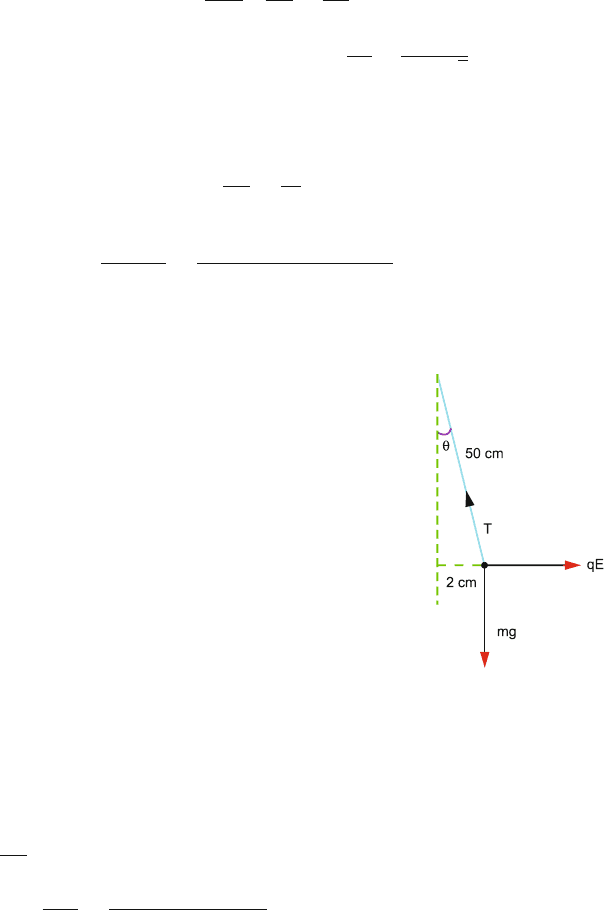
11.3 Solutions 489
Work done in carrying the charge q from C to B will be
W
CB
= U(B) − U(C) =
qq
1
4πε
0
1
AB
−
1
AC
= 5 ×10
−9
× 6 × 10
−8
× 9 × 10
9
1
0.1
−
1
(0.1)
√
2
= 7.9 ×10
−6
J
11.13 The problem is similar to prob. (11.6), Fig. 11.23. For equilibrium T sin θ =
qE, T cos θ = mg,tanθ =
qE
mg
∼
2
50
= 0.04
∴ E =
0.04 mg
q
=
(0.04)(0.5 × 10
−3
)(9.8)
3 × 10
−10
= 6.53 ×10
5
N/C
which is directed away from the equilibrium position.
Fig. 11.23
11.14 The electric field E = V/d where V is the PD and d is the distance of
separation of plates. The electric force on the droplet is F = qE = qV/d.
If the upper plate is negative then the condition for equilibrium against grav-
itational force acting downwards is
qV
d
= mg
V =
mgd
q
=
10
−14
× 9.8 × 0.01
3.2 × 10
−19
= 3062.5V
If the polarity of the plates is reversed, both the electric and gravitational
forces would act down. The net force would become
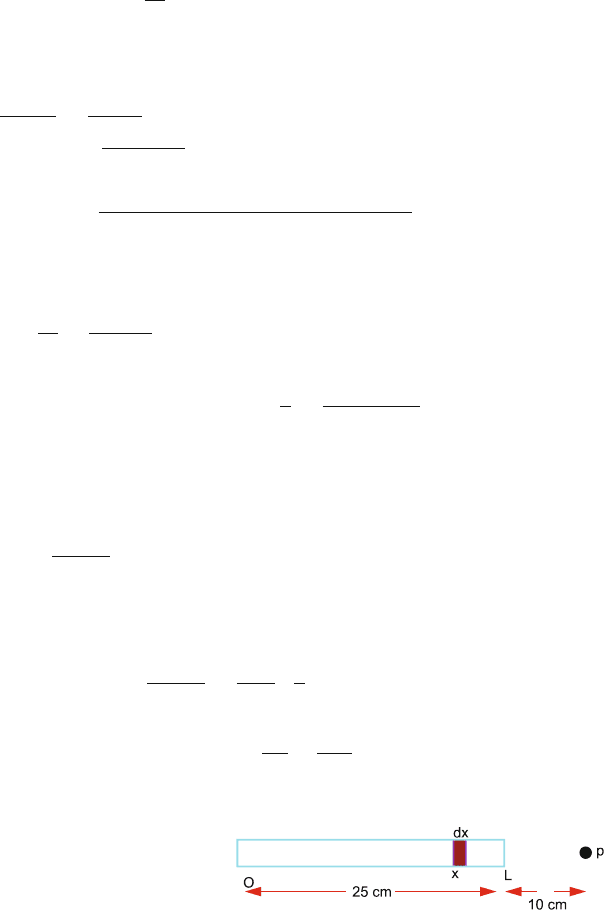
490 11 Electrostatics
F
= qE + mg = 2 mg
Acceleration a =
F
m
= 2g = 2 × 9.8 = 19.6m/s
2
11.15 Let q be the charge on each body. Electric force = gravitational force
q
2
4πε
0
r
2
=
GMm
r
2
q =
4πε
0
GMm
=
6.67 × 10
−11
× 6 × 10
24
× 7.4 × 10
22
9 × 10
9
1/2
= 5.736 ×10
13
C
11.16 Energy W = qV
q =
W
V
=
10
−5
5 × 10
6
= 2 ×10
−12
C
Number of electrons flowed out =
q
e
=
2 × 10
−12
1.6 × 10
−19
= 1.25 ×10
7
11.17 Consider an element dx of the rod at distance x from the point P on the axis
of the rod. In the length dx the charge is dq = λdx,Fig.11.24.
The field at P due to dq will be
dE =
λ dx
4πε
0
x
2
The total electric field will be
E =
dE =
0.35
0.1
λ dx
4πε
0
x
2
=
λ
4πε
0
·
1
x
0.1
|
0.35
= 200 ×10
−6
× 9 × 10
9
×
1
0.1
−
1
0.35
= 1.286 ×10
7
N/C
Fig. 11.24
11.18 Let p be the field point on the axis of the disc at distance z from the origin.
Consider a ring of radius r and width dr. The charge on the ring is dq =
2πr dr σ where σ is the charge density (charge per unit area), Fig. 11.25.
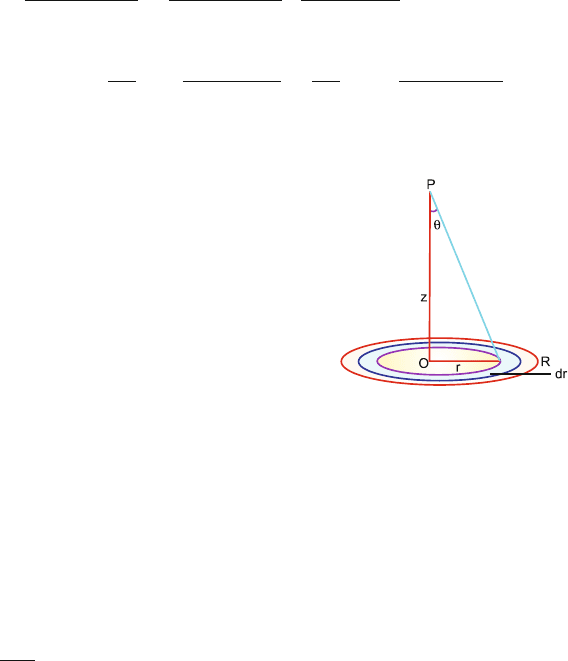
11.3 Solutions 491
The electric field at P can be resolved into a component along the z-axis
and perpendicular to it. The perpendicular components when added become
zero for reasons of symmetry. The components along the z-axis are added
dE
||
=
dq cos θ
4πε
0
(z
2
+r
2
)
=
2π r dr σ
4πε
0
(z
2
+r
2
)
·
z
(z
2
+r
2
)
1/2
E =
dE
||
=
σ
2ε
0
z
R
0
rdr
(z
2
+r
2
)
3/2
=
σ
2ε
0
1 −
z
(z
2
+ R
2
)
1/2
Fig. 11.25
11.19 Equations of motion are
eE + mg − 6πηv
1
r = 0 (downward field)
eE − mg − 6πηv
2
r = 0 (upward field)
Adding and solving for e
e =
3πη
E
(v
1
+ v
2
)r
11.20 Consider an element of the circular wire ds (Fig. 11.26). Then dq = λds.
Now ds = r dθ
∴ dq = (λ cos
2
θ)(rdθ)
∴ q =
dq = λ
0
r
2π
0
cos
2
θdθ = πλ
0
r
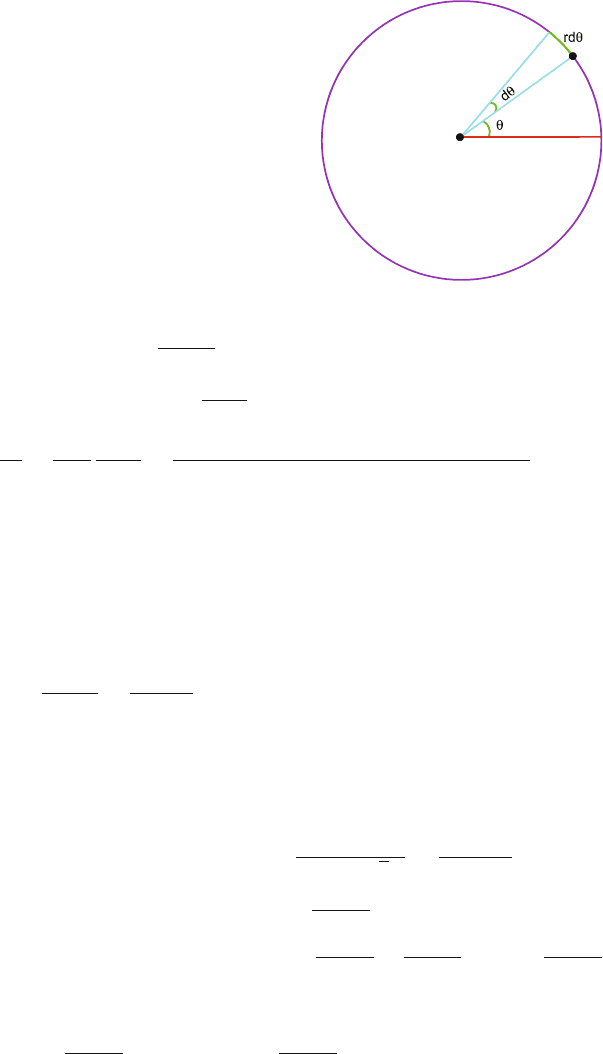
492 11 Electrostatics
Fig. 11.26
11.21
Electric force F
e
=
q
2
4πε
0
r
2
(11.48)
Gravitational force F
g
=
GMm
r
2
(11.49)
F
e
F
g
=
q
2
4πε
0
1
GMm
=
(1.6 × 10
−19
)
2
(9 × 10
9
)
(6.67 × 10
−11
)(1.66 × 10
−27
)(9.1 × 10
−31
)
(11.50)
= 2.29 ×10
39
(11.51)
The distance is immaterial. Note that the gravitational force at the atomic and
sub-atomic levels is small simply because the masses are small.
11.22
q
1
+q
2
= 15 μC(1)
F =
q
1
q
2
4πε
0
r
2
=
9 × 10
9
(0.3)
2
q
1
q
2
= 5.4
or q
1
q
2
= 54 (μC)
2
(2)
Solving (1) and (2), q
1
= 6 μC, q
2
= 9 μC.
11.23 At P, the electric field due to +q is
q
4πε
0
(a/
√
2)
2
or
2q
4πε
0
(a)
2
and points
towards +2q. The field due to +2q is
4q
4πε
0
a
2
and points towards +q.The
resultant field due to the pair (q,2q)is
4q
4πε
0
a
2
−
2q
4πε
0
a
2
or E
1
=
2q
4πε
0
a
2
towards +q.
Similarly, the resultant filed due to the pair of charges (−q, −2q) will be
E
2
=−
2q
4πε
0
a
2
towards −2q or +
2q
4πε
0
a
2
towards −q.
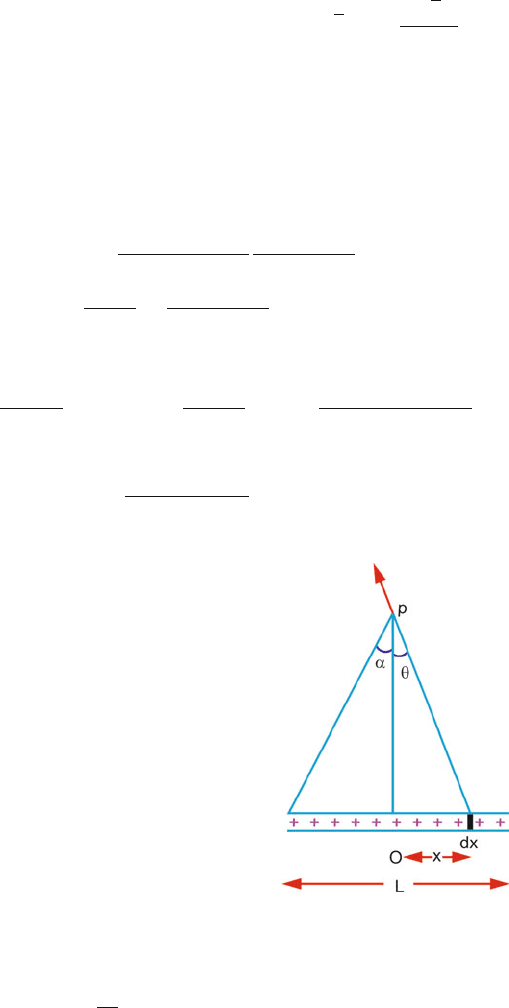
11.3 Solutions 493
Now E
1
= E
2
in magnitude and act at right angles (from the geometry
of the diagram). The overall field will then be E =
√
2 E
1
=
2
√
2q
4πε
0
a
2
along
positive y-axis.
11.24 Consider an infinitesimal length dx at distance x from O, the centre of the
rod. The charge on dx will be dq = q
(
dx/L
)
. The field at P due to dq shown
by an arrow can be resolved into x- and y-components. The x-component of
the field will be cancelled by a symmetric charge on the negative side at equal
distance. The y−components of the field will be added up, Fig. 11.27.
dE
y
= dE cos θ =
qdx
4πε
0
L(x
2
+ y
2
)
y
(x
2
+ y
2
)
1/2
∴ E =
dE
y
=
qy
4πε
0
L
dx
(x
2
+ y
2
)
3/2
Put x = y tan θ,dx = y sec
2
θdθ
E =
q
4πε
0
Ly
α
−α
cos θ dθ =
q
2πε
0
Ly
sin α =
q
2πε
0
(4y
2
+ L
2
)
1/2
where we have put sin α =
L/2
(y
2
+ L
2
/4)
1/2
.
Fig. 11.27
11.25 Consider an element of angle between θ and θ +dθ. Let OP be the bisector of
angle θ
0
subtended by the arc AB at the centre O. The charge on the element
of the arc adθ will be q
dθ
θ
0
. The electric field at O due to this element of arc
can be resolved E
||
along PO and E
⊥
perpendicular to it.
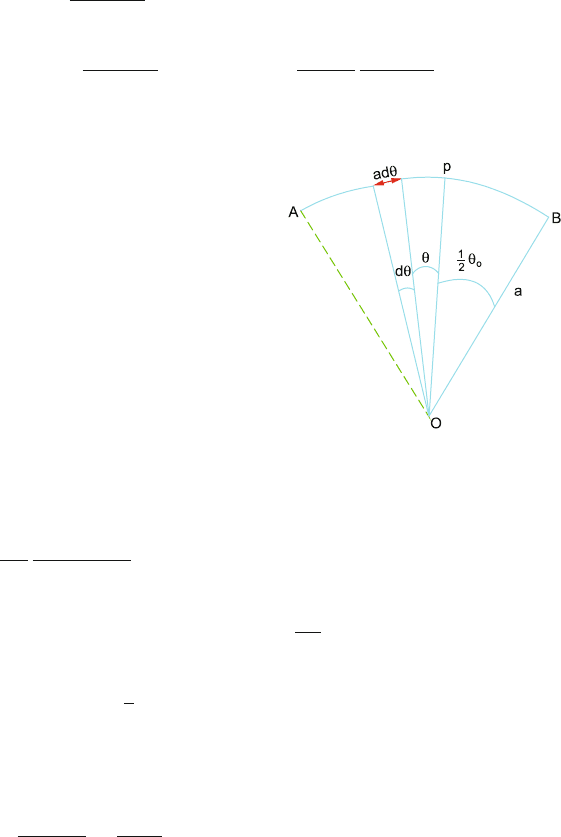
494 11 Electrostatics
The perpendicular components will be cancelled for reasons of symmetry
while the parallel components get added up, Fig. 11.28.
dE = dE
=
q dθ
4πε
0
θ
0
a
2
cos θ
E =
dE
=
q
4πε
0
θ
0
a
2
θ
0
/2
−θ
0
/2
cos θ dθ =
q
2πε
0
a
2
sin(θ
0
/2)
θ
0
Fig. 11.28
11.26 The electric field at distance z from the centre of the ring on the axis of the
ring is given by prob. (11.3)
E =
λr
2ε
0
z
(z
2
+r
2
)
3/2
The maximum field is obtained by setting
∂ E
∂z
= 0.
This gives (z
2
+r
2
)
1/2
(r
2
− 2z
2
) = 0.
Since the first factor cannot be zero for any real value of z, the second
factor gives z = r/
√
2.
11.27 Consider a circular strip symmetric about z-axis of radius r and width adθ
(Fig. 11.29). The charge on the strip is
dq = q
2πradθ
2π a
2
=
qr dθ
a
= q sin θ dθ
(a) At the centre of the hemisphere, the x-component of the field will be
cancelled for reasons of symmetry. The entire field will be contributed
by the z-component alone.
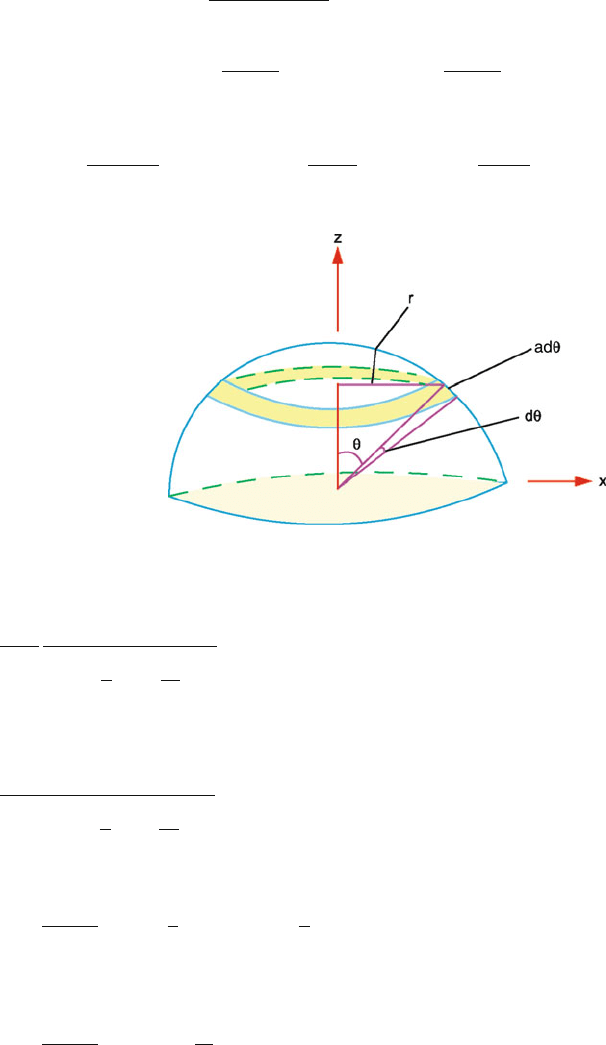
11.3 Solutions 495
dE = dE
z
=
q sin θ dθ cos θ
4πε
0
a
2
∴ E =
dE
z
=
q
4πε
0
a
2
π/2
0
sin θ cos θ dθ =
q
8πε
0
a
2
(b)
dV =
q sin θ dθ
4πε
0
a
; V =
dv =
q
4πε
0
a
π/2
0
sin θ dθ =
q
4πε
0
a
Fig. 11.29
11.28 The x-component of the field due to front charges will get cancelled and the
y-component is added up to
2q
4πε
0
a/2
r −
a
2
2
+
a
2
4
1/2
along the negative y-axis, Fig. 11.30.
Similarly the field due to the other two charges will be
2q · a/2
4πε
0
r +
a
2
2
+
a
2
4
3/2
along the positive y-axis.
Neglecting terms of the order of a
2
, the net field will be
E =
qa
4πε
0
r
3
1 −
a
r
−3/2
−
1 +
a
r
−3/2
Using the binomial expansion up to retaining terms linear in a,
E =
3qa
2
4πε
0
r
4
. Then E α
1
r
4
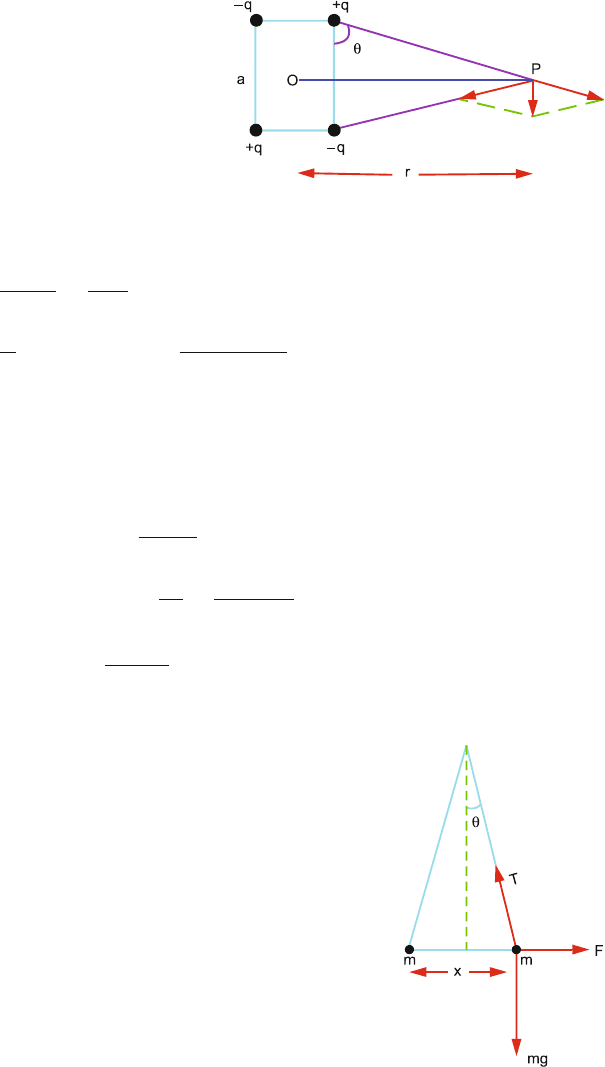
496 11 Electrostatics
Fig. 11.30
11.29 The electric force F
e
= the gravitational force
q
2
4πε
0
r
2
=
Gm
2
r
2
q
m
= (4πε
0
G)
1/2
=
6.67 × 10
−11
9 × 10
9
1/2
= 8.65 ×10
−9
C/kg
11.30 Consider the equilibrium of one of the spheres, Fig. 11.31.IfT is the tension
in the string then
T cos θ = mg
T sin θ =
q
2
4πε
0
x
2
∴ tan θ θ =
x
2L
=
q
2
4πε
0
mgx
2
∴ q =
2πε
0
mg
L
1/2
x
3/2
Fig. 11.31
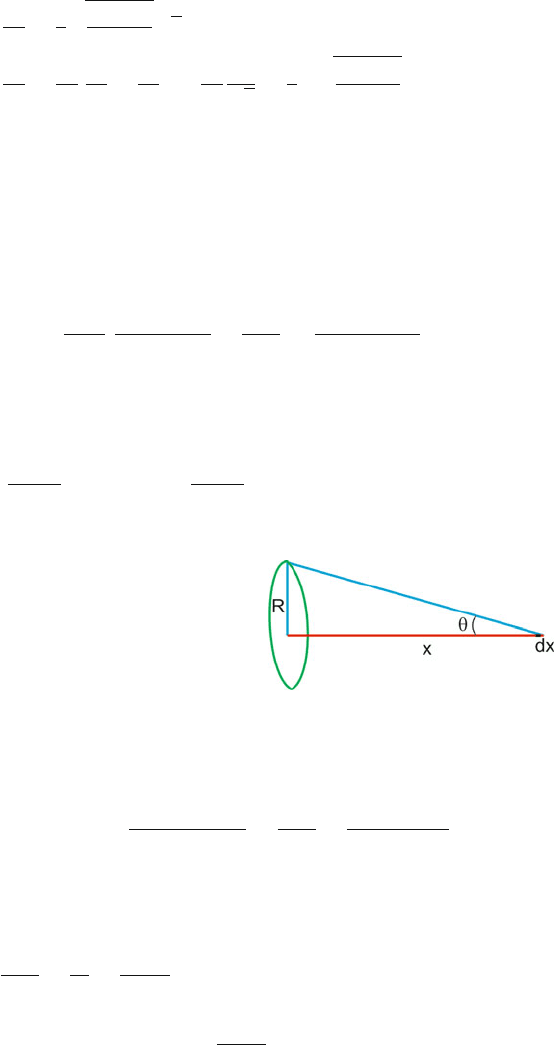
11.3 Solutions 497
∴
dq
dx
=
3
2
2πε
0
mg
L
√
x
dq
dt
=
dq
dx
dx
dt
=
dq
dx
v =
dq
dx
a
√
x
=
3
2
a
2πε
0
mg
L
11.31 Consider an element of length dx of the thread at distance x from the
centre of the ring. The force between the ring and the element dx can be
resolved into x- and y-components, Fig. 11.32.They-component will get
cancelled for reasons of symmetry. The field is entirely contributed by the
x-component. The charge in length dx is λdx. The electric force between the
wire and the ring is given by
F = F
x
=
1
4 πε
0
q λ dx cos θ
(R
2
+ x
2
)
=
qλ
4πε
0
∞
0
xdx
(x
2
+ R
2
)
3/2
Put x = R cot θ ,dx =−Rcosec
2
θ dθ
F =−
qλ
4πε
0
R
0
π/2
cos θ dθ =
qλ
4πε
0
R
Fig. 11.32
11.32 Consider an element of wire dx at distance x from O, Fig. 11.33. The charge
in dx will be λdx.Thex-component of the electric field will be
E
x
=
E sin θ =
λdx sin θ
4πε
0
(x
2
+ y
2
)
=
λ
4πε
0
∞
0
x dx
(x
2
+ y
2
)
3/2
Put x
2
+ y
2
= z
2
, x dx = z dz
where y = constant.
E
x
=
λ
4πε
0
∞
y
dz
z
2
=
λ
4πε
0
y
Similarly, E
y
=
E cos θ =
λ
4πε
0
y
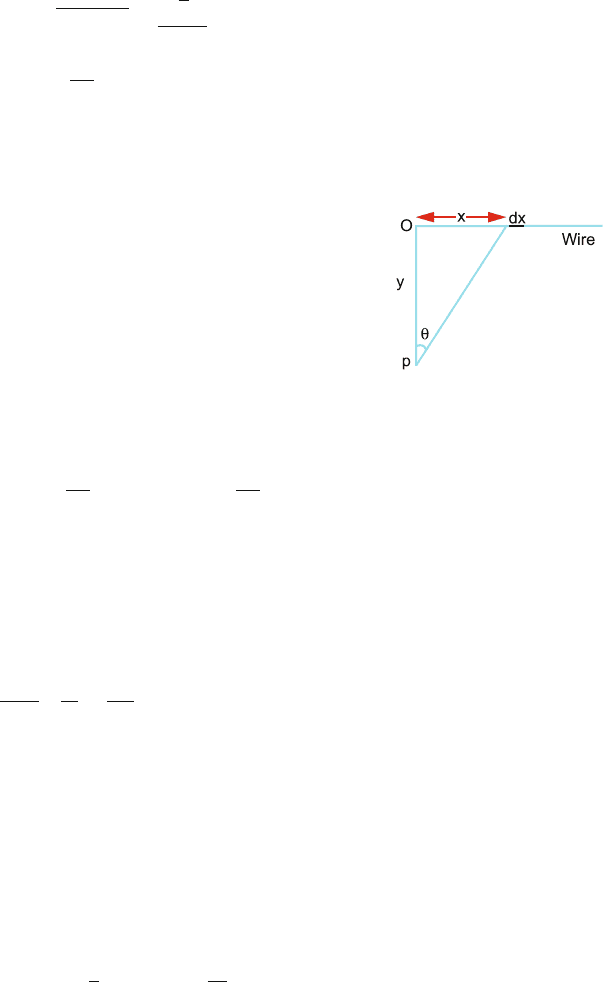
498 11 Electrostatics
E =
E
2
x
+ E
2
y
=
√
2 λ
4πε
0
y
tan α =
E
y
E
x
= 1 → α = 45
◦
Thus
E makes an angle 45
◦
with the y-axis.
Fig. 11.33
11.33
φ = Cxy
E
x
=−
∂φ
∂x
=−cy, E
y
=
∂φ
∂y
=−cx
∴
E =−c(y
ˆ
i + x
ˆ
j)
11.34 Let the charges Q and −2Q be located on the x-axis at distance x on the
opposite side of the y-axis. Let the point P(x, y) be at distance r
1
from Q
and at r
2
from −2Q,Fig.11.34. By problem
1
4πε
0
Q
r
1
−
2Q
r
2
= 0
or r
2
= 2r
1
(1)
Writing r
2
1
= (x +a)
2
+ y
2
(2)
and r
2
2
= (a − x)
2
+ y
2
(3)
and eliminating r
1
and r
2
in (1), (2) and (3) and simplifying
3x
2
+ 3y
2
+ 10xa + 3a
2
= 0
or
x +
5
3
a
2
+ y
2
=
16
9
a
2
which is the equation to a circle.
